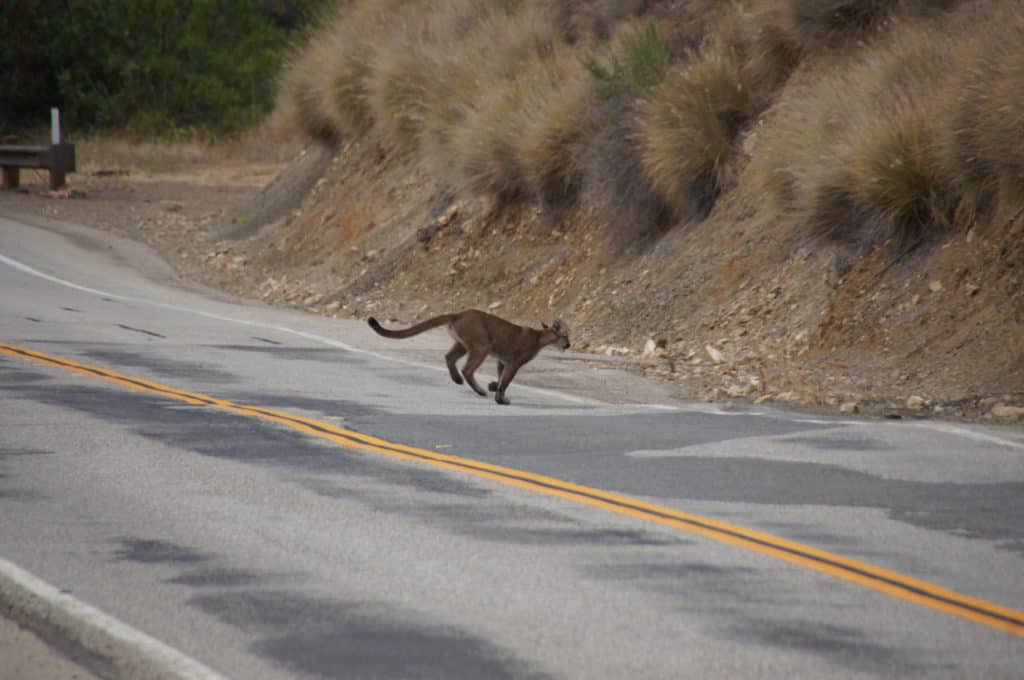Share this article
Mountain lions become efficient during COVID-19 shutdown
The Hollywood mountain lion dubbed P-22 moved around much less than it usually did during the early months of the COVID-19 shutdown. Famous for being the most urban mountain lion in greater Los Angeles, P-22 has lived in Griffith Park—where the iconic Hollywood sign appears—for about a decade.
“He used a smaller area than he has historically,” said John Benson, an assistant professor of vertebrate ecology at the University of Nebraska and the lead author of a study recently published in Ecological Solutions and Evidence on mountain lion activity around Los Angeles during the early months of the pandemic.
Benson’s co-authors from the National Park Service have been tracking mountain lions (Puma concolor) for nearly two decades in the Santa Monica Mountains and surroundings areas. They’ve followed P-22 for more than nine years, he said.
In 2020, from March 27 until May 9, national and state parks were closed due to the pandemic, resulting in much less human activity. Benson and his colleagues studied 12 mountain lions with GPS collars in the area during the 43-day period to see how the relative lack of human activity affected the way the animals used the landscape. They compared the GPS data with human activity data pulled from Google Analytics, which tracks the amount of cellphone use in certain areas and provide a good indicator of human presence and activity in a given area at a given time.

The lack of humans around may have contributed to an increase in efficiency for mountain lion movement. Credit: National Park Service
“There was this expectation that animals were going to be expanding their ranges and reclaiming areas that humans typically dominate,” Benson said.
But they were surprised to find just the opposite. By and large, cougars moved around much less during the shutdown. The mountain lions also used smaller areas in that period compared to other similar 43-day periods in other years or in other seasons, the researchers found.
Benson said this is likely because cougars didn’t have to sidestep around certain areas as much. The big cats were closer to human trails and development during the park closures compared to before the pandemic, the GPS data showed.
“When they didn’t have to avoid or dodge around human activity on the landscape as often, they were able to shrink those ranges and move more efficiently,” he said.
The results suggest that during normal times when there isn’t a pandemic, mountain lions tend to move inefficiently in an effort to avoid human activity. They travel larger distances than they need to and use more space.

The shutdown may not have reduced traffic enough to allows mountain lions to cross many major roads at a higher rate. Credit: National Park Service
The researchers were also curious to see whether the pandemic might allow the cougars to cross the highways that restrict them to the Santa Monica Mountains. These formidable obstacles to gene flow have long been a concern for the mountain lion population in the area—crossings are rare. Young lions hemmed into the area are restricted in their ability to disperse as a result, causing sometimes fatal conflict with other lions. Lions that do try to cross sometimes get struck and killed by cars.
But the researchers didn’t find any instances of collared mountain lions crossing the largest freeways that surround the Santa Monica Mountains. They crossed secondary roads at the same rate before, during and after the pandemic. Though traffic slowed during the early portion of the pandemic, Benson said that it may not have declined enough for cougars to want to cross major roads more frequently.
“It’s still Los Angeles; it’s not like there wasn’t anyone out on the road,” Benson said. Or the shutdown may not have provided enough time for the mountain lions to change their behavior.
This data may suggest that humans walking on trails have less impact on the overall movement of mountain lions than the freeways do, he said.
As for P-22, data showed the cougar moved around a lot less during the day during the pandemic shutdown, though its night movements didn’t change much. The pandemic may have just allowed it a little more time to move around at its leisure.
Header Image: Cougars moved less during the COVID-19 shutdown. Credit: National Park Service








